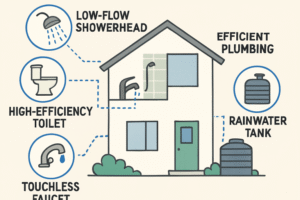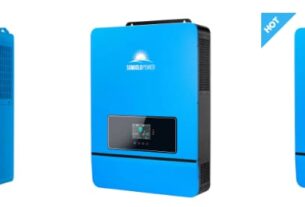Introduction
Water conservation is becoming an increasingly important priority for today’s environmentally conscious homeowners. As climate change exacerbates droughts and threatens natural water sources, responsible consumption is no longer a choice but a necessity. Fortunately, recent innovations in plumbing technology make it easier than ever to drastically reduce water consumption around the home without sacrificing performance or everyday comfort. Whether you are renovating or building new, numerous options are available that can significantly reduce your home’s water usage. For residents seeking Gaithersburg plumbing support, implementing modern water-saving solutions can have a significant impact not only on utility bills but also on long-term environmental sustainability. Upgrading plumbing is an investment in your home’s future, one that benefits future generations and helps to maintain the delicate balance of our ecosystem.
The integration of water-saving fixtures, advanced monitoring systems, and eco-friendly plumbing upgrades can transform homes into efficient and sustainable living spaces. These solutions reduce waste, conserve water, and lower the household’s carbon footprint by minimizing energy consumption for heating water, treating wastewater, and supporting utility infrastructure. This combination of practicality, cost savings, and environmental responsibility makes these upgrades a sensible choice.
High-Efficiency Toilets
Older toilets can use as much as 3.5 gallons per flush, leading to significant water waste, especially in larger households or homes with frequent guests. This waste can go unnoticed for years, needlessly increasing your water bill and environmental impact. High-efficiency toilets (HETs) were designed to address this problem by dramatically reducing the volume of water needed for each flush; most HETs use just 1.28 gallons or less per flush without compromising flushing performance. Many models now offer dual-flush systems that allow users to select a lower volume for liquid waste and a slightly higher amount for solid waste, providing even more control over consumption. For a year, a family could save up to 16,500 gallons of water simply by replacing their old toilets with high-efficiency models, a change that quickly pays off on your utility bills.
Low-Flow Showerheads
Showering accounts for 17% of the average household’s water usage. Older showerheads can deliver 2.5-3 gallons per minute, causing significant water consumption. Modern low-flow showerheads reduce the flow rate to below 2 gallons per minute (gpm), ensuring both comfort and functionality. These devices use air injection or aerating technologies to maintain consistent pressure and a satisfying spray. Some models also offer pause settings or adjustable spray patterns. The EPA estimates that installing these fixtures can save an average family up to 2,700 gallons of water annually, conserving both water and reducing water heating costs.
Touchless Faucets
Touchless faucets have evolved from being purely high-end luxury items to practical, affordable additions to almost any home. These faucets employ motion sensors to detect when hands are present, triggering the water to flow only when needed and shutting it off automatically when no longer in use. This not only helps eliminate the common problem of taps left running during handwashing, food prep, or cleaning, but also makes them particularly useful for families with children or elderly members who may forget to shut off taps. The added cleanliness of touchless operation helps reduce the spread of germs and bacteria, which is especially important in kitchens and bathrooms. Over time, these faucets can save hundreds of gallons of water each year while providing modern convenience. With the cost of touchless technology expected to decrease significantly in 2025, homeowners can upgrade with minimal expense and see immediate returns.
Tankless Water Heaters
Traditional water heaters store and continuously heat a large tank of water, resulting in both energy and standby water loss as heat escapes and the heater reheats the tank. Tankless water heaters, also known as on-demand heaters, provide a modern solution by heating water instantly as needed. This system eliminates the energy loss associated with keeping a tank full of hot water, resulting in lower utility bills and a smaller carbon footprint. Tankless units are compact, allowing for installation in tight spaces, and are especially suited for homes where energy efficiency is a top concern. These heaters provide a constant supply of hot water, whether you need to run multiple appliances simultaneously or take a long shower. Additionally, they tend to have longer lifespans when properly maintained.
Greywater Recycling Systems
Greywater refers to relatively clean wastewater generated from baths, sinks, laundry, and showers, which, after minimal treatment, can be safely reused for non-potable applications such as landscape irrigation or toilet flushing. Installing a greywater recycling system helps lower a home’s total water demand, reducing reliance on municipal supplies and making the most of every drop. Many municipalities are now encouraging the reuse of greywater as part of broader water conservation initiatives, especially in regions affected by persistent droughts or water shortages. With systems now available from compact units for single bathrooms to whole-house solutions, it’s easier than ever for eco-conscious homeowners to incorporate greywater recycling into their remodeling plans. Over time, using greywater can reduce stress on public utilities and contribute to localized environmental sustainability.
Rainwater Harvesting Systems
Rainwater harvesting is a traditional concept that’s been revolutionized with modern systems capable of capturing and storing large volumes of rain runoff from rooftops. Once collected, this water can be filtered and used for non-potable household needs such as garden irrigation, landscaping, flushing toilets, or laundry. Some advanced systems even integrate filtration that makes rainwater safe for drinking and bathing. By reducing your dependence on public water utilities, rainwater harvesting helps lower your water bill and provides an essential backup in times of drought or water restrictions. As urban populations grow and natural resources become increasingly scarce, more homeowners are turning to rainwater harvesting as a practical and sustainable way to secure their water supply and reduce their ecological footprint.




